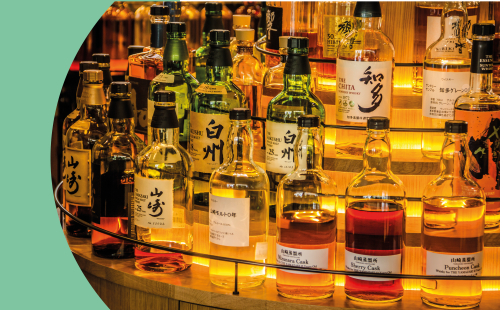When you think of Japanese drinks, Sake is the one that most likely springs to mind, but while Sake is well established as THE Japanese drink, it’s not the only one. If you’ve never heard of Shochu, it’s not because it’s new—it’s been around in Japan since the 16th century.
But, it didn’t really make it out of Japan until recently, and now that it has, it’s quickly gaining popularity. There are currently approximately 635 Shochu distilleries in Japan, and, while it’s always been popular in its own country, it’s going through a significant boom right now. Here we take a look at what Shochu is, and why you should try it.

What is Shochu?
The first thing to say is, if you’re familiar with Sake, Shochu is nothing like that.
While Sake is a fermented drink, like wine but a little stronger at 13-17% ABV, Shochu is a distilled drink, more like vodka but not as strong at 20-30% ABV. So, while both drinks fall somewhere in between wine and spirits in their alcohol content, Shochu is much stronger than Sake and tastes very different.
Shochu is mostly made from sweet potato—this is the most popular kind and the one you’ll find most readily available—but other types of Shochu are made from barley, buckwheat, sugar cane and rice.
Different brands of Shochu will taste different, depending on the ingredients, how it’s made and how many times it’s distilled. Singular distillation is the authentic way of making Shochu and is called ‘otsu-rui’ Shochu. You will also notice a difference in the colour of different brands of Shochu, depending on what they are made from and how they are made.
Shochu is typically aged for three years, traditionally in an earthenware or glass jar.
How to drink Shochu
Just like Sake, Shochu is traditionally served either warm or cold. You can drink it straight, with some ice, or mixed with cold water or soda water, but in Japan it is also served mixed with hot water to create a sweeter mulled kind of drink.
Now that Shochu is becoming more popular in the west, it’s also being used as a great base for a cocktail. Here are some examples:

Sencha Shochu
Shake 2 oz of Shochu, 1 egg white, ½ oz of simple syrup, ¾ oz of lemon juice, and 1 tbsp of Sencha tealeaves. Add ice and shake again. Double strain into your cocktail glass and garnish with tea leaves.

Ginger and chili Oyuwari
Slice some fresh ginger and chili pepper and place directly into a glass. Fill the glass half way with hot water, mix and allow to sit for a minute or two. Then simply add your Shochu to taste.
The Snoosh
Shake 1 oz of Lychee juice, 0.5 oz of banana liqueur, 0.5 oz triple sec, 0.75 oz lime juice, and 1 egg white. And ice and shake well. Strain into your cocktail glass and garnish with grapefruit peel and shiso leaves.
Maia
Created by Takuma Watanabe, who owns Martiny’s in New York.
Shake ½ oz of basil syrup (a blend of simple syrup and fresh basil), 2 oz pineapple juice, ½ oz yuzu juice, and 1 ½ oz Shochu, with ice. Strain into your cocktail glass and garnish with basil leaves
What to pair with Shochu

The kind of food that goes best with your Shochu depends on which kind of Shochu you’re drinking.
- Because sweet potato Shochu, known as Imo, is quite sweet, and fragrant it pairs well with fatty foods like pork and hot spicy foods, so it goes well with a katsu curry.
- Shochu made from barley, Mugi, is a much cleaner-tasting Shochu, and it goes well with smoked meats or smoked salmon. It’s usually paired with quite simple dishes.
- Rice Shochu, called Kome, as you might expect, has a neutral taste, though it can have a sweet aftertaste. It goes really well with seafood dishes and anything with a creamy taste to it.
- Sugarcane Shochu, Kokuto, is the dessert wine of Shochus and has a syrupy taste to it. It’s usually paired with dishes made with soy sauce and with any dessert.
- The only Shochu that has a slight bitterness to it is Soba, a buckwheat Shochu, which means it pairs well with spicy foods, but it’s also great with a meaty pasta dish.
- Lastly, there is a Thai rice Shochu called Awamori, which has a much richer flavour than Kome and goes well with cheese dishes or with banana fritters.
How to buy Shochu
Shochu, and not Sake, is actually the national drink of Japan, and it’s sold everywhere in Japan. But most of the Shochu made stays in its country of origin and isn’t exported. This means your choice of Shochu to drink and buy outside of Japan is pretty limited. We are seeing more varying brands and types of Shochu making their way around the world, but it’s still nothing like the choice you have while in Japan.
Wherever you are in the world, you can buy a bottle of Shochu pretty easily online. If you want to drink it in a bar, there are a few options we can point you to that showcase this intriguing spirit around the globe.
On Charlotte Street in London, there’s a cool Shochu Lounge where you can try some Shochu and sushi, with knowledgeable bar staff who can give you recommendations of which to try and how to drink it.
In Ho Chi Minh City in Vietnam, Mangetsu Shochu Bar is a restaurant and bar dedicated to pairing the best Japanese food with the best Shochu.
In New York’s West Village, En is a Japanese brasserie that serves 60 kinds of Japanese whisky, 80 types of Sake, and 36 different Shochus. The pairing of the best in Japanese cuisine with traditional Japanese drinks, plus a vinyl music bar, makes this a popular place with locals and tourists.
As Shochu becomes more popular and more brands make their way around the world, we’re sure to see more Shochu bars opening, so stay tuned.





